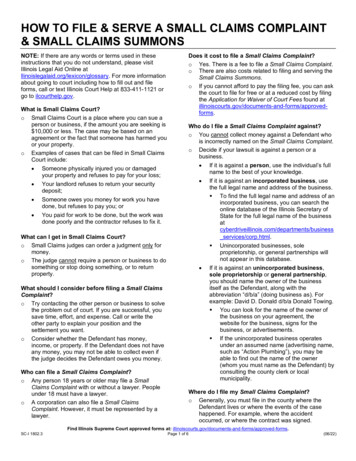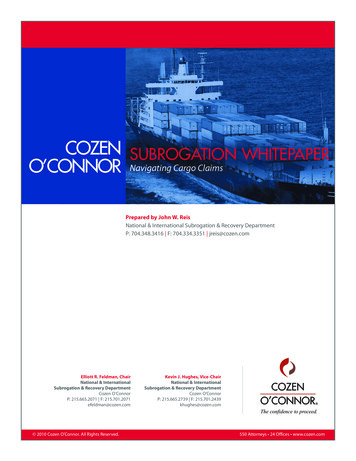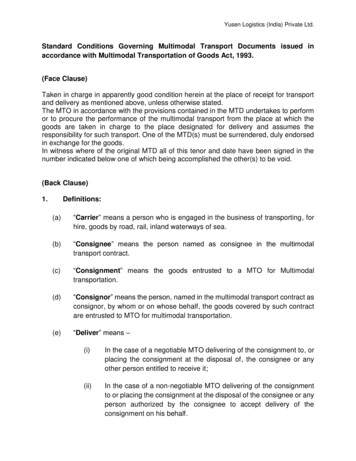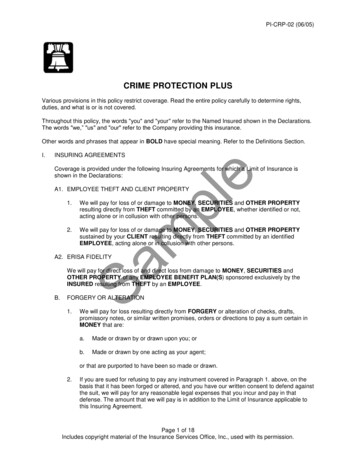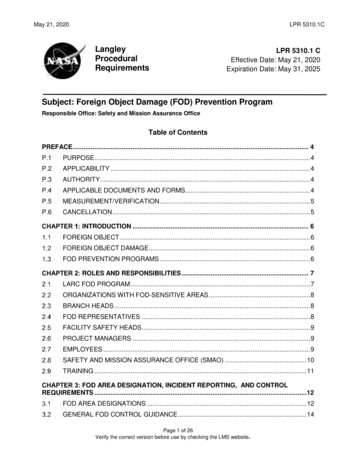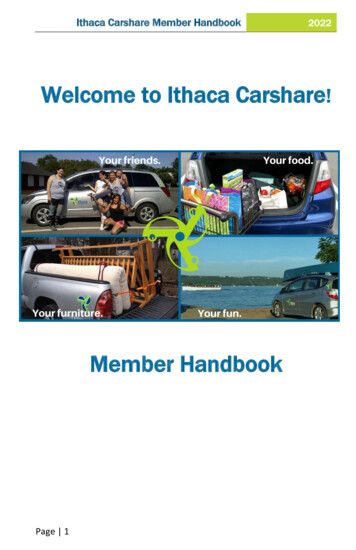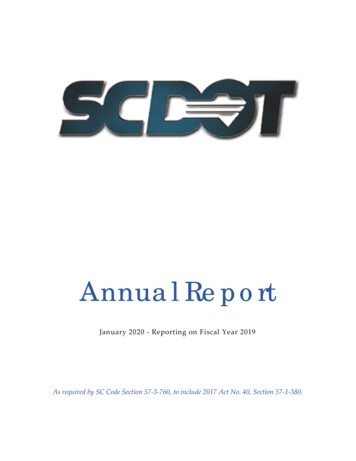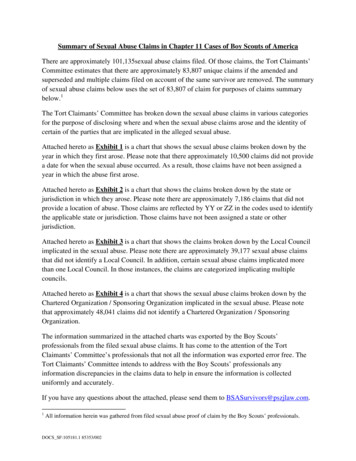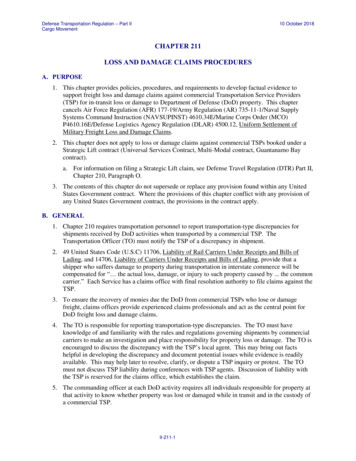
Transcription
Defense Transportation Regulation – Part IICargo Movement10 October 2018CHAPTER 211LOSS AND DAMAGE CLAIMS PROCEDURESA. PURPOSE1. This chapter provides policies, procedures, and requirements to develop factual evidence tosupport freight loss and damage claims against commercial Transportation Service Providers(TSP) for in-transit loss or damage to Department of Defense (DoD) property. This chaptercancels Air Force Regulation (AFR) 177-19/Army Regulation (AR) 735-11-1/Naval SupplySystems Command Instruction (NAVSUPINST) 4610.34E/Marine Corps Order (MCO)P4610.16E/Defense Logistics Agency Regulation (DLAR) 4500.12, Uniform Settlement ofMilitary Freight Loss and Damage Claims.2. This chapter does not apply to loss or damage claims against commercial TSPs booked under aStrategic Lift contract (Universal Services Contract, Multi-Modal contract, Guantanamo Baycontract).a. For information on filing a Strategic Lift claim, see Defense Travel Regulation (DTR) Part II,Chapter 210, Paragraph O.3. The contents of this chapter do not supersede or replace any provision found within any UnitedStates Government contract. Where the provisions of this chapter conflict with any provision ofany United States Government contract, the provisions in the contract apply.B. GENERAL1. Chapter 210 requires transportation personnel to report transportation-type discrepancies forshipments received by DoD activities when transported by a commercial TSP. TheTransportation Officer (TO) must notify the TSP of a discrepancy in shipment.2. 49 United States Code (U.S.C) 11706, Liability of Rail Carriers Under Receipts and Bills ofLading, and 14706, Liability of Carriers Under Receipts and Bills of Lading, provide that ashipper who suffers damage to property during transportation in interstate commerce will becompensated for “ the actual loss, damage, or injury to such property caused by . the commoncarrier.” Each Service has a claims office with final resolution authority to file claims against theTSP.3. To ensure the recovery of monies due the DoD from commercial TSPs who lose or damagefreight, claims offices provide experienced claims professionals and act as the central point forDoD freight loss and damage claims.4. The TO is responsible for reporting transportation-type discrepancies. The TO must haveknowledge of and familiarity with the rules and regulations governing shipments by commercialcarriers to make an investigation and place responsibility for property loss or damage. The TO isencouraged to discuss the discrepancy with the TSP’s local agent. This may bring out factshelpful in developing the discrepancy and document potential issues while evidence is readilyavailable. This may help later to resolve, clarify, or dispute a TSP inquiry or protest. The TOmust not discuss TSP liability during conferences with TSP agents. Discussion of liability withthe TSP is reserved for the claims office, which establishes the claim.5. The commanding officer at each DoD activity requires all individuals responsible for property atthat activity to know whether property was lost or damaged while in transit and in the custody ofa commercial TSP.II-211-1
Defense Transportation Regulation – Part IICargo Movement10 October 20186. Internal controls must ensure that all unit activities (Supply, Maintenance, or Distribution) workin conjunction with the TO to provide valid data for use when reporting transportationdiscrepancies. Controls must also ensure that discrepancies are investigated and reported to theclaims office accurately, completely, and timely.C. PROCEDURES1. Before claim action can be initiated, the TO must complete three actions:a. Initiate Report. Transportation personnel must gather facts on the time, place, andcircumstances of an in transit property loss or damage.b. Additional Development. Coordinate the loss or damage investigation with other offices andobtain legal or technical help as necessary.c. Evaluate Responsibility. Determine who is responsible for the loss or damage.2. Initiating Claim Action. Calculate the amount of loss or damage. Determine if the TSP isresponsible for the loss or damage. When the loss or damage is less than 500, file a claimagainst the TSP, following the procedures outlined in Figure 211-1, Local Claim FilingGuidelines. When the loss or damage exceeds 500, send a completely documented DD Form361, Transportation Discrepancy Report (TDR), Figure 211-4 (Source Document for Claims), tothe finance center or claims office for action.D. INVESTIGATING DISCREPANCIESThe primary purpose of discrepancy investigation is to determine responsibility for loss or damageand establish the full actual loss to the Government. The TO must conduct a full and impartialinvestigation of the responsibility for loss or damage. The investigation must establish such factors asproximate cause of damage, measure of loss or damage, market value (or Federal Supply Catalog orDefense Logistics Agency [DLA] Consolidated Management Data List value), preshipment reparablevalue, salvage allowance, depreciation, inspection by the TSP or Government, actual repair cost, anddisposition of damaged property.E. EVALUATING FACTUAL INFORMATION AND EVIDENCEThe TO enters only factual information when describing discrepancies and clearly defines thecircumstances surrounding the loss or damage in the “Remarks” (Block 36) section of the TDR.When facts are established from oral testimony, the person giving the testimony must be identified byname and position. Direct statements must be quoted.F. SHIPPER OR CONTRACTOR RESPONSIBILITYThe TO may obtain findings of the Contract Administration Office as to shipper or contractor liabilityunder the contract. When such responsibility is indicated, these findings are required even if TSPliability is involved. (Use the SF 364, Report of Discrepancy (ROD), Figure 211-5, for reporting,adjusting, and accounting for supply-type discrepancies.)G. DETERMINING LIABILITY1. Common Law Rule. A common TSP is liable for the loss of, or damage to, property received fortransport. The TSP can justify or excuse a default where a loss or injury occurs through:a. Natural Disaster. As defined, an event that could not happen by the intervention of man, orbe prevented by human skill, knowledge, or foresight. It includes extraordinary floods,storms, unusual lightning, sudden tempests, severe frosts, earthquakes, tidal waves, and theII-211-2
Defense Transportation Regulation – Part IICargo Movement10 October 2018like. A natural disaster is such unusual and extraordinary manifestation of the forces ofnature that it could not, under normal conditions, be anticipated or expected. It justifies thefailure of the common TSP to perform its contract of carriage and relieves it of the liabilityfor the loss of or injury to the property. The rule, however, is not absolute. Although loss orinjury to property results from a natural disaster, if the TSP is negligent in avoiding orlessening the loss or damage, it is liable. For example, the rule does not apply if:(1) The TSP fails to obtain or ignores local reports of severe storms and brings the propertyinto contact with the destructive force.(2) The event is not the immediate or only cause of the loss or damage. As an example, theTSP takes property into an area recently struck by an earthquake, ignoring reports ofunsafe roads and unstable buildings and requests to remain clear of the area. If the TSPis involved in an incident that damages the property, it is liable. The earthquake was notthe immediate cause of the damage.(3) A freezing condition occurs at a season of the year or in a climate where freezingweather is to be reasonably expected.b. Act of the Public Enemy. TSPs are not liable for loss or damage caused by acts of organizedmilitary or naval forces of a nation at war with the United States. Groups such as mobs,rioters, or strikers are not considered as the “public enemy” and losses caused by them do notfall within this exception.c. Act or Mandate of a Public Authority. Common TSPs are under the control of publicauthority to the same extent as other persons, and must equally obey the orders of properlyconstituted government officials. If freight is lost or damaged as a result of obedience to suchorders, without any intervening fault of the TSP, the TSP will not be held responsible.d. Act or Fault of the Shipper. A common TSP is not liable for any loss or injury resulting fromthe act or fault of the shipper without fault on the part of the TSP. This exception to theTSP’s common law liability includes every case where the loss is caused by the shipper’s act,whether that act is one of negligence, misconduct, or misfortune. The rule most frequentlyapplies to cases of loss due to defective packing and improper loading.(1)Three elements must be present to give the rule effect: the shipper performed thepacking or loading; there was a defect in the packing or loading; and, the defect wasconcealed from ordinary observation.(2)If the TSP acknowledges improper packing or loading, or if either is apparent uponordinary observation and inspection, it is the duty of the TSP to refuse receipt of theproperty. If the TSP accepts the property, the TSP cannot be relieved of liability forloss or injury resulting from the defective packing or improper loading.e. Defects in or Inherent Vice of Property. This exception arises from the nature and existingcharacter of the property carried. A TSP is not liable for loss or damage to a shipmentresulting from an existing defect in the property shipped and not caused or contributed to byTSP negligence. Generally, exceptions are made on perishable goods shipments subject todecay, fermentation or evaporation. Of a more complex nature, and harder to prove as todefect or inherent vice, are items of property subject at the time of shipment to metal fatigue,defective welding, structural weakness, faulty workmanship, or poor material integrity. ATSP is not an insurer against loss caused by the nature, vice, or infirmity of the propertyshipped. Under federal rules, when a TSP shows that the damage resulted from the inherentinfirmity of goods transported under circumstances shown not to be negligent, the burden ofproving negligence rests with the claimant.II-211-3
Defense Transportation Regulation – Part IICargo Movement10 October 2018H. BEGINNING OF LIABILITYA common TSP assumes liability when it receives freight under its control (e.g., as soon as thedelivery is complete and the possession of the goods is transferred from the shipper to the TSP). Noformal acceptance is necessary. If a bill of lading (BL) was not receipted, this does not necessarilyindicate that the TSP did not accept the goods. Delivery cannot be complete if there is something thatmust be done by the shipper before the goods can be forwarded. However, if it is the TSP’sresponsibility to deliver the material without further shipper action, the TSP’s liability has begun.I. TSP DUTY TO PROTECT PROPERTYA TSP’s duty is not limited to the transportation of goods delivered for carriage. Law requires theTSP to protect the goods from preventable destruction and injury. The carrier must guard the goodsfrom destruction or from the elements, the effects of delays, or other sources of damage that, byexercising care and ordinary intelligence, it could anticipate and prevent.J. COMMON TSP FAULTS1. The TSP is responsible for loss or damage, when:a. A fire, wreck, or other casualty, not directly attributable to a natural disaster, destroys theproperty in its possession.b. The loss or injury is attributable to a combination of a natural disaster and the negligence of aTSP. If the loss or damage could have been averted had the TSP acted with caution orefficiency, the TSP may not be relieved of liability. See the second example under thenatural disaster exception.c. The freight disappears while in its possession; this includes theft or pilferage.d. The freight is delivered, without authority, to other than the designated consignee.e. The freight is damaged through rough handling in transit, at TSP’s terminals, or transferpoints.f.Defective or inadequate packing or loading is readily apparent and could be observed by theTSP at time of acceptance, but the TSP still accepts the shipment for transport.g. The TSP fails to provide safe and adequate service, equipment, or facilities for the transportof the property.h. The shipper seals the freight and the TSP breaks the seal(s).(1) Truckload (TL)/Carload (CL) freight. If the TSP breaks the seal(s) en route to thedestination, reseals the freight, and then delivers freight short or damaged, the TSP maybe held liable.(2) Less-Than-Truckload (LTL)/Less-Than-Carload (LCL) freight. If the TSP breaks theseal(s) at the local terminal or first BB point and discovers shortage/damage, but fails tonotify the shipper of discrepancies, the TSP may be held liable.i.The TSP fails to properly load, stow, block, or brace a LCL or LTL shipment.II-211-4
Defense Transportation Regulation – Part IICargo Movement10 October 2018K. COMMON SHIPPER FAULTS1. The TSP may be relieved of responsibility for loss or damage occurring en route when it can beproven that the shipper:a. Failed to ship items described or listed on the BL.b. Failed to package and pack the shipment properly.c. Failed to use suitable containers (e.g., pallets, skids) for shipment.d. Failed to load, stow, block, and brace a CL or TL shipment properly.e. The examples above do not apply if the TSP knew about the improper lading, loading, orsimilar deficiency or if such were apparent upon ordinary observation. The TSP is notrelieved of liability if a deficient shipment is accepted for transport.L. MEASURE OF LOSS AND DAMAGE - DETERMINING VALUE1. Right to Recover Money. The DoD is entitled to payment for the actual loss of or damage toproperty. The Government’s damages will be measured as determined by principles of law. Theexact amount of loss or damage must be documented. Claims for commercial TSP loss ordamage to Government property are based on firm evidence and documented facts. The burden ison the Government to prove the loss or damage occurred while the property was in the TSP’spossession. Evidence submitted must support both the charge of TSP responsibility and theamount of the Government’s loss, including any incidental damage arising from the loss ordamage to the property. Incidental damages are those expenses reasonably and necessarilyincurred by the Government to restore the property or to mitigate the damages. The actual valueof the lost or destroyed property may be at market value at the time of the shipment.2. Property Valuation at “market value”. The term “market value” is not always applicable toGovernment property. Some DoD property is not suitable for commercial or industrial use, andvaluable for military purposes only, with no comparable commercial market value. The lawprovides that the measure of loss or damage to an article having no “market value” is the value ofthe article to the owner (14 American Jurisprudence, Second Edition. § 631, Carriers).3. Contracts, purchase orders, and invoices are acceptable proof of value and sometimes apply whenan item moves from the manufacturer to the first Government destination. However, theseprocurement documents are not maintained as a means of determining property value after thepurchased items are placed in the federal property system. Price quotations may be obtained froma variety of supply systems (e.g., FED LOG) and become the authority for the value of the lost ordamaged item. The price quote is based on the average purchase of like items procured by DLA,the Defense Contract Management Agency, the General Services Administration, or the Serviceunder contract for the same period. These costs are usually less than open market prices due tothe volume of purchases.4. If, for some reason, the value is unknown or there is doubt concerning the pre-shipment value ofan item lost or damaged, consult the Item Manager (IM), who determines value based onconsideration of original cost, utility and use, condition and age, and extent, if any, to which it hasdeteriorated or depreciated. If there is a continuing need for a like or similar item, and there arenone available in the supply system, the value may be the estimated cost to reproduce or replacethe item (including transportation cost) less allowances, for preshipment condition of the propertylost or irreparably damaged.5. Sometimes lost or damaged property has no value other than as scrap. The property may beobsolete or shipped for disposal through the established property disposal channels. If theproperty has no value other than as scrap, that value will represent the measure of loss.II-211-5
Defense Transportation Regulation – Part IICargo Movement10 October 2018M. PROPERTY DEPRECIATION1. Many items of government property, although classified as serviceable (material condition codeA), are depreciated in value at time of shipment from one site to another. When “used” propertyis lost, irreparably damaged, or damaged beyond economical repair, the level of depreciationmust always be considered when determining the amount of the Government’s actual loss.2. For property in “pre-shipment reparable” condition, both depreciation allowance and averagestandard cost of repair may apply for computation of the actual loss. When there is a continuingneed for an item and it must be replaced, the amount of loss is based on the adjusted replacementcost. Obtain it by deducting the depreciation to the used item from the cost of a new like item.For property that will not be replaced, the amount of loss is determined by deducting thedepreciation allowance from the original cost or the supply system price quotation under whichthe property was carried in DoD inventory.3. Usually, a depreciation rate is based on the service-life expectancy of an item of property. TheIM of the class of property will maintain these rates. When a depreciation allowance applies, theTO requests it from the IM. Depreciation allowances based on the technical knowledge of the IMwill establish a sound basis for an equitable claim. The statement of depreciation allowance mustaccompany the TDR, and must show factors considered and the method used to compute thedepreciation allowance. The depreciation allowance statement documents the claim against theTSP. The statement will include:a. Date of purchase and manufacturer.b. Original acquisition cost.c. Replacement cost of a like item and source of this quotation.d. Estimated or published life expectancy (if published, give the source).e. Preshipment condition.f.Current need to the DoD.g. Average standard repair cost, when an item was shipped in “reparable” condition.h. See Figure 211-2 for an example of a pre-shipment value statement.N. REPAIRS AND COSTS1. As with all elements of damages, the cost of repair (actual or estimated) must be shown to bereasonable.2. Actual Costs. When damage occurs to DoD property and the damage can be repaired, thedamages are measured by the cost of the repair necessary to restore the property to its conditionbefore the injury. The DoD is not entitled to any portion of the repair cost that makes theproperty more valuable than it was before the injury. If the cargo was shipped with pre-existingdamage, a needed repair or for update prior to shipment, that cost is deducted from the actualrepair cost. The TSP cannot be charged for a pre-existing condition, only for the damage itcaused.3. Several options exist when repairs are made to the damaged property. Some repair actionsfollow. The property owner must work with the TO to determine the proper course of action andacquire the necessary funds for repair. The claims office does not furnish the funds for repair. Inall instances, the matter will be coordinated with the TSP before repairs are made.4. Property on Which Repairs Will Be Estimated. It is not necessary to spend money or owe arepair bill to recover the cost of repair (78 American Law Reports [A.L.R.] 905). When repairII-211-6
Defense Transportation Regulation – Part IICargo Movement10 October 2018will not be made, repairs will be delayed due to lack of parts or backlog in the repair facility, orwhen the damaged property must be shipped to another facility for repair, use the estimated repaircosts to settle claims.O. TSP REPAIR OF DAMAGED PROPERTY1. The TSP may repair damaged property (except classified and protected cargo).NOTE: Do not release TOP SECRET, SECRET, CONFIDENTIAL, sensitive, or technicalsupplies or equipment to a TSP for repairs.When the TSP performs the repairs, the TSP must agree in writing to:a. Restore the damaged property to the condition it was in when the Government released it forshipment.b. Repair the damaged property to meet military or contract specifications.c. Repair the property promptly.d. Return the repaired property to the releasing activity or other activity directed to receive it,without undue delay.e. TO will obtain a receipt for the property when released to the TSP for repairs. When theabove conditions have been met, the TDR will be canceled as no claim against the TSP iswarranted.P. TSP REPLACEMENT OF DAMAGED PROPERTY1. The TSP may elect to replace damaged property at no cost to the Government. When the TSPreplaces damaged property, it must agree, in writing to:a. Replace the damaged item with an identical one.b. Replace the damaged item promptly.c. Deliver the replacement item damage-free.2. The TO will give the damaged item to the TSP for salvage or disposition and cancel the TDR asno claim action is warranted. However, do not release TOP SECRET, SECRET,CONFIDENTIAL, sensitive, or technical supplies or equipment to a TSP.Q. REPAIR OF DAMAGED PROPERTY1. When DoD property is damaged in transit and a claim is filed against the TSP, the TSP is entitledto receive an itemized repair cost statement (breakdown) of the actual repair costs relating to thedamaged item. The repair cost statement will contain parts, labor, and overhead as separateitems.2. Transportation Charges to Repair Facility. When it is necessary to send damaged property to arepair activity, add the freight transportation cost(s) to and from the repair facility to the TDR.When damaged property is sent to a repair activity, then transshipped, the transportation costchargeable may not exceed the original transportation charges to the repair activity and back tothe original BL destination location. If the item is a replacement, the record must show that asecond item was shipped to replace the damaged item. Normally, this charge will not exceed thecost of sending the damaged item to and from the repair facility, provided the replacement isshipped from the facility by the same mode. Transportation charges to and from repair activitiesmust be supported by copies of the BL, TSP’s freight bills, and a statement showing that theII-211-7
Defense Transportation Regulation – Part IICargo Movement10 October 2018repair could not have been made locally at less cost by a government facility or a commercialfirm.3. Prevention of Loss of Identity at Repair Facility. Because of the administrative costs involved,repair facilities do not maintain repair cost data for each item repaired. They can, however,provide the actual itemized repair cost data for repair of in transit damages when the reportingactivity properly marks the damaged property for shipment to the repair facility and shows thatseparate repair cost data is needed for freight loss and damage claim action. To prevent loss ofthe damaged items and their actual repair cost data at the repair facility, the reporting activitymust:a. Notify repair facility’s transportation personnel and request they alert the IM andmaintenance shop or facility of pending shipment of damaged property and the requirementfor separate actual repair cost data for claim action against the TSP. Ensure the BL, shippingdocument, and “reparable” tag attached to the damaged property are all annotated to show theoffice responsible for the TDR, file reference number, BL number, and that the actual repaircosts to the specific item are required to file a freight loss and damage claim against the TSP.b. Ensure the repair facility/maintenance shop is capable of and responsible for providing theactual repair cost statement, when the reporting activity places them on notice that separateactual repair cost data is required.c. If the item loses its identity at the place of repair and another is shipped to replace it, includetransportation charges for the replacement item on the TDR.R. REPAIR COSTS CHARGED BY MILITARY FACILITIES WITH A COST ACCOUNTINGSYSTEMIn addition to the direct costs of material and labor, Services must include the overhead costs for theclaim. Where a cost accounting system is used, the overhead costs provided by that system will beincluded in the repair cost statement. If the overhead costs are not provided by the cost accountingsystem, repair costs will be computed using the procedures in Paragraph T. Figure 211-3 is anexample of a repair cost statement.S. REPAIR COSTS (DIRECT AND INDIRECT) CHARGED BY MILITARY FACILITIESWITHOUT A COST ACCOUNTING SYSTEM1. Activities that do not have detailed cost accounting data will compute the cost of repair work asfollows:a. For repair work performed by civilians, charge the cost of the regular civilian time plus 42.9percent, which covers the cost of annual leave, sick leave, holidays, and contributions toemployee benefit programs.b. Add the direct cost of any civilian overtime to (a) above, but do not add the 42.9 percent tothe overtime rate.c. Add the direct cost of work performed by military personnel to subparagraphs a. and b.above. Use the standard daily or hourly rates published in service personnel cost directives.Multiply the number of hours or days worked times the standard rate, plus 32 percent of thetotal standard rate for enlisted personnel and 20 percent for officers, as prescribed in pertinentService personnel cost directives. These percentages cover the leave, holidays, and certainother personnel costs not included in the standard rate.d. Increase the sum of subparagraphs a., b., and c. above by 30 percent. This percentage coverscosts such as administration, heat, light, and water.II-211-8
Defense Transportation Regulation – Part IICargo Movement10 October 2018e. Increase direct material costs by 3.5 percent as prescribed in pertinent service personnel costdirectives for accessorial costs (packing, crating, and handling) of material issued from stockfor use in repair of damaged items. Add this amount to the sum of subparagraphs a., b., c,and d.f.If subassembly items or parts recovered incident to repair of the damaged article are salvaged,the TSP is entitled to the salvage value of those recovered items/parts, less any costs toprocess the salvage. Subtract the salvage value from the total repair costs.T. PROPERTY NOT TO BE REPAIRED1. If property will not be repaired, either ship the property to the item or inventory manager fordisposal or return the material to storage.2. Receiving TOs will obtain itemized estimates of repair costs as soon as possible. Estimates willbe prepared and signed by technically qualified personnel who are familiar with labor costs, parts,and overhead.3. The TO must tell the TSP that:a. The property will not be repaired.b. A technically qualified person computed the estimated cost of repair.c. The claim will be settled based on estimated cost.U. PROPERTY NOT TO BE IMMEDIATELY REPAIRED1. When repair delays occur, use the estimated repair cost to establish the measure of damage.2. Estimated repair costs are subject to adjustment when the actual repair charges are determined.The TO must obtain and report the actual cost of repairs to the claims office.3. The claims office will inform the TSP that:a. There will be a delay before the property can be repaired.b. A technically qualified person computed the estimated cost of repair.c. The DoD is filing its claim based on the estimate.d. The TSP will settle the claim based on the estimate, subject to adjustment when actual repairis completed.V. DISPOSITION OR SALVAGE OF DAMAGED PROPERTY1. When a determination is made to salvage the damaged property accepted by the Government, theTSP must be notified of the intent to salvage. If release of the property is not restricted, it may beoffered to the TSP. A TSP is entitled to credit for the salvage value of property not released to it.Such credit does not apply if the recoverable amount of the shipment claim under releasedvaluation is less than the Government’s actual loss.2. When articles are damaged to the point they must be scrapped, the TSP must be allowed credit forthe value of the scrap recovered. Deduct the cost of processing the salvage for sale from thesalvage value.3. The policies for disposal or salvage of TSP -damaged property are contained in transportation,materiel, and security directives. Field activities must arrange to dispose of TSP -damagedproperty according to their Service directives for handling unserviceable property. The claimsoffice does not furnish disposition instructions or funds for disposition.II-211-9
Defense Transportation Regulation – Part IICargo Movement10 October 2018W. DISPOSITION OF TSP -DAMAGED PROPERTY MOVING UNDER RELEASED RATESA TSP liability for loss or damage to Government property may be limited to the released valuationcited in the TSP’s tender or schedule of rates and on the BL. When the BL cites “released valuation,”field activities must not release damaged property to TSPs for salvage when the released valuation oramount recoverable from the TSP is less than the actual property value.X. DISPOSITION OF EXPLOSIVES AND OTHER DANGEROUS ARTICLES1. Damage to explosives and other dangerous articles, especially where damage cannot be readilynoted, present a special situation. R
3. To ensure the recovery of monies due the DoD from commercial TSPs who lose or damage freight, claims offices provide experienced claims professionals and act as the central point for DoD freight loss and damage claims. 4. The TO is responsible for reporting transportation-type discrepancies. The TO must have
